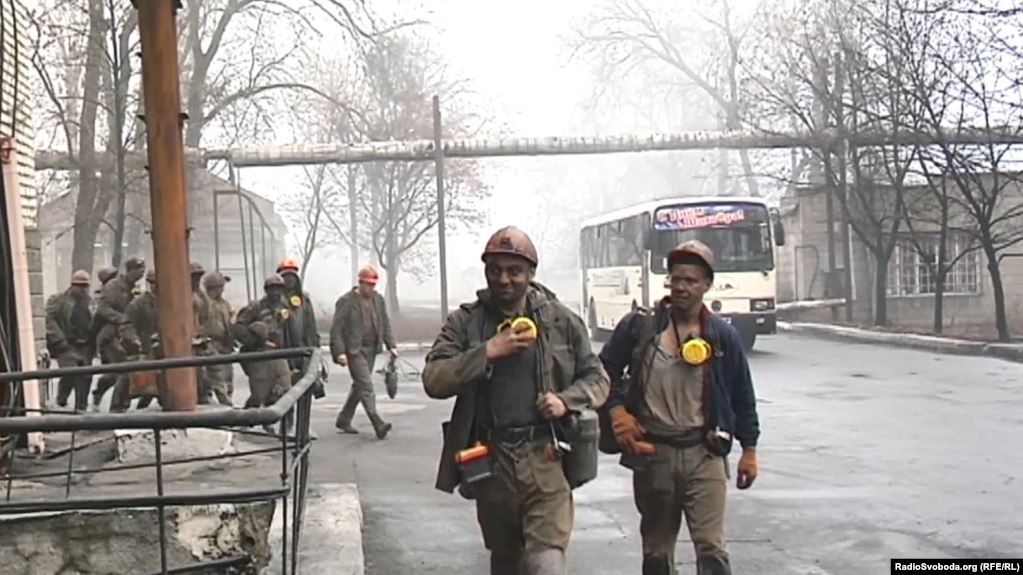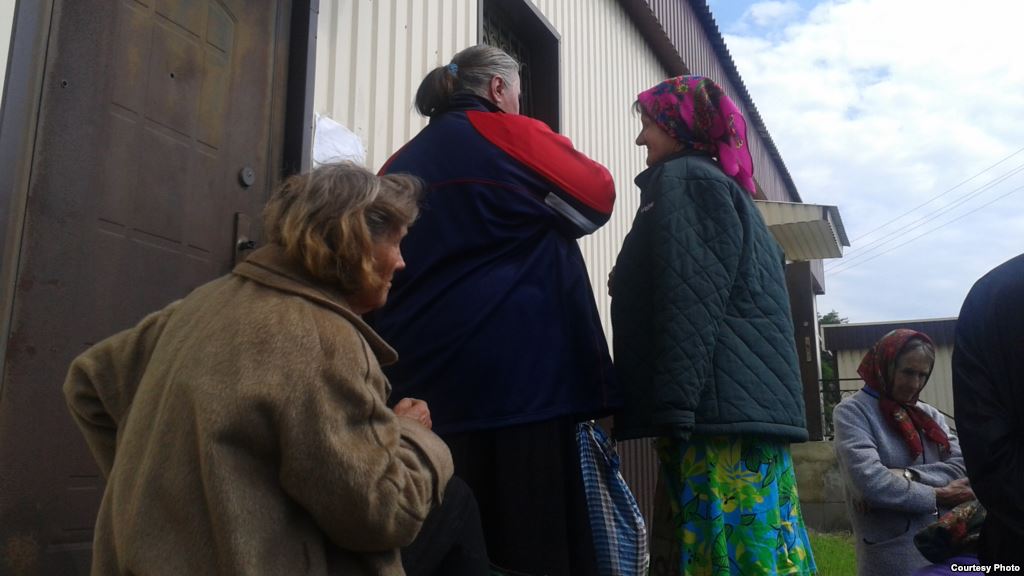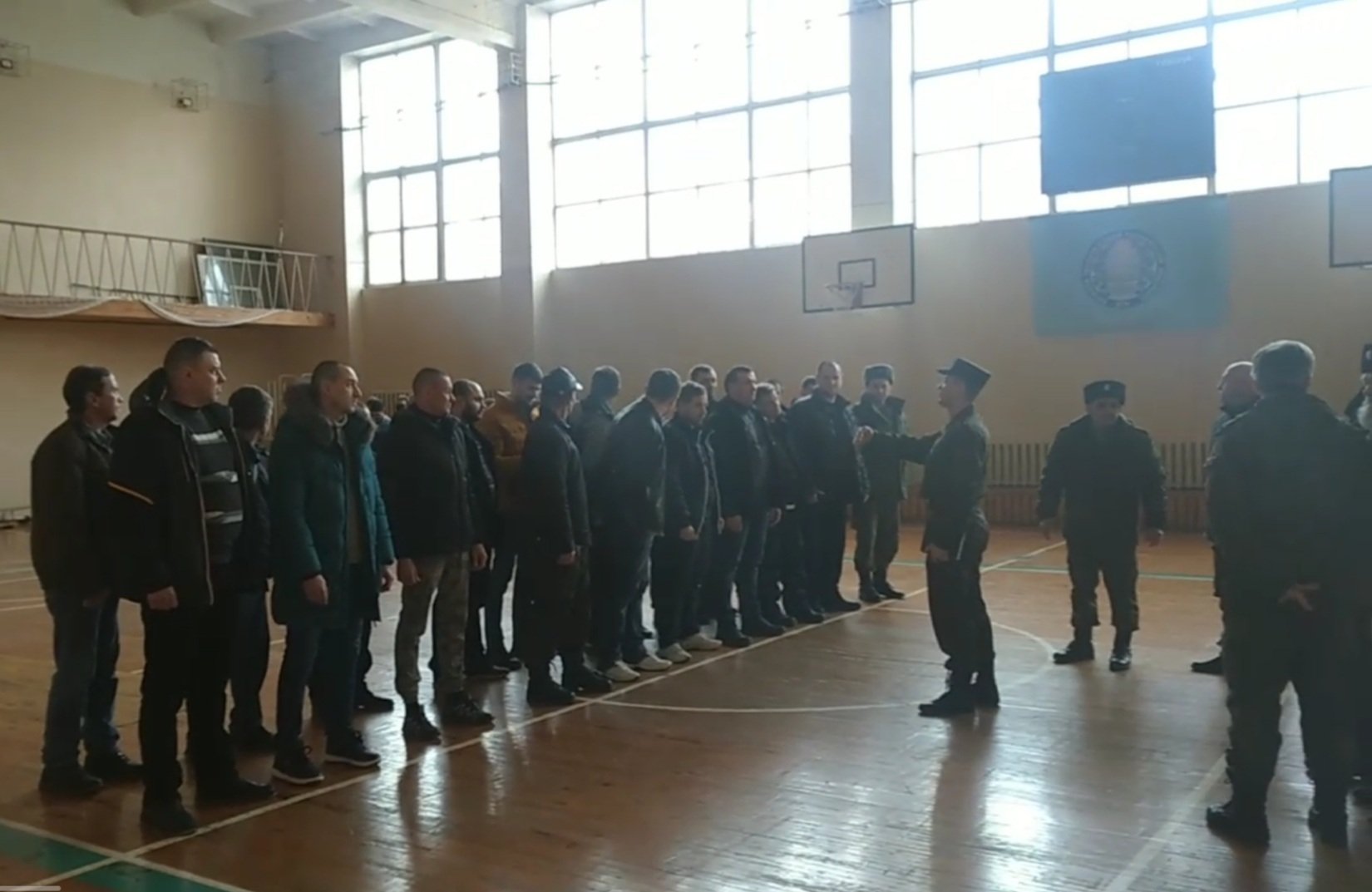However, the local coal miners occasionally dared to protest against wage delays and coal mine closures. Lately, the change of the external management of the seized mines in the occupied territory and plans to “restructure the coal industry” (read: “to close most of the mines pushing jobless workers to illegal mining”) fueled a wave of strikes and protests unseen in previous years of the Russian occupation.
The recent miners’ strikes have been making headlines and the impossibility to hide the protests forces the occupation authorities of Luhansk and Donetsk to make concessions to strikers at least in terms of delivering the delayed wages. However, most of the still-operating mines will be closed anyway.
Wave of strikes
A year ago, propagandists in the occupied territories filmed staged TV segments on the glittering future of the Nikanor-Nova mine in Zorynsk, ORLO, assuring that “the coal industry in LNR keeps reviving.”
However, in late April and early May, some 50 miners of Nikanor-Nova in Luhansk Oblast, protested against the planned closure of the mine by the occupation authorities for six days underground and demanded they be paid six months-worth of wages. This time, the protesters couldn’t reach any of those “LNR” shills who promised them a bright future last year.
On 7 April, employees of Donetsk-based Zasiadka mine (ORDO) refused to return to the surface when their shift ended and demanded the payment of the salary arrears. They remained underground for several hours until their management reportedly paid off most of the debt.
The protesting Zorynsk coal miners came out to the surface on the 4 May, when the so-called "LNR minister of energy and coal industry," Pavel Malygin, visited them underground and promised to pay their wages by 25 May. Soon, the workers received their payments for last October and November out of six-month arrears. However, the pre-planned "dry mothballing" of their mine, i.e. shutting down all operations but pumping out the groundwaters,, remained on the table.
The strike showed
the locals that underground protests force the occupation authorities into negotiation since they can’t just storm the gassy mines to arrest the protesters underground, risking to trigger a methane explosion.
By June, four more ORLO-based mines were going to strike. The “LNR MGB” ("ministry of state security") managed to prevent underground protests at three of them - the mines of Vakhrusheve (Yasenivskyi, Rovenki), Bilorichenska (Bilorechenskyi settlement), Frunze (Rovenki) - by closing the mines before the shifts of protesters were able to go down a shaft, the “instigators” of the protests were arrested.
Despite the activities of the MGB, a shift of 119 miners at the Komsomolska mine in the town of Antratsyt, however, succeeded in going on strike and even declared a hunger strike. The occupation authorities restricted entry to the city and attempted to block internet access and mobile communications.
From 7 June, the Vodafone Ukraine mobile network became inaccessible around Antratsyt. According to a Euromaidan Press source, Vodafone had been down in the regional capital city of Luhansk as well.
On 12 June, around 100 people rallied in Antratsyt to support the coal miners who were striking at the Komsomolska mine in the town’s settlement of Dubovskyi. The protesters demanded to stop the crackdown on strikers and be paid their delayed wages.
A video tweet dated 12 June cites a post in a local social media group,
Шахтеры вышли на небольшой митинг к администрации города Антрацит. После начала акции в городе была отключена не только связь «Лугаком» , но и пропал интернет ЛТК. Произошло это около 12:00. pic.twitter.com/Jj42R7wic1
— hochu dodomu v UA (@hochu_dodomu) June 12, 2020
Here is another footage of the Antratsyt rally,
The protests received media coverage in Ukraine and Russia and made the occupation authorities stop using repressive measures. They started releasing the arrested miners.
Promised to get paid their wage arrears, the Antratsyt coal miners ascended to the surface after the seven days of the strike. According to the so-called Labour Party of Russia, as of 20 July, “all of 22 coal miners” held by MGB were released.
Strikes: a consequence of unprofitable coal mines being shut down
Vera Yastrebova, the head of the NGO Skhidna Pravozakhysna Hrupa (“Eastern Human-Rights Group”) that has been closely following the developments in Donbas miners' towns, told RFE/RL that all unprofitable coal mines in the occupied part of Luhansk Oblast - 23 in total - were closed.
The occupation authorities keep operational only those mines that still can generate profit without any substantial investment. The latter includes four mines of the Krasnodonvuhillia enterprise (based in Sorokyne), three mines in the town of Rovenki, one in the Antratsyt town, four in Sverdlovsk (Dovzhanskyi), and one more in Bilorechenka.
"These mines are not problematic, while other closed mines have problems with payments, people there have unpaid arrears of wages which caused the massive protest. For example, the mines of Krasnyi Luch (Khrustalnyi - Ed.) owed more than 300 million rubles to their workers, but these mines were just closed without paying anything to the people," she explained.
Most of those mines were closed through so-called "wet conservation," which requires no decommission operations: underground waters flood the subsurface facilities without being pumped out; hence the term “wet.” Of course, the equipment and constructions degrade underwater and it makes it almost impossible to refurbish such a mine to resume normal operations in the future.
Leaving alone the threats flooded mines pose to local ecosystems, the consequences for local economies are appalling since the mines have been township-forming enterprises in the communities and closing a mine means mass unemployment: hundreds of workers have to look for jobs in other fully-staffed coal mines that are still operational or find illegal employment at so-called kopanki - extremely dangerous makeshift coal mines that offer manual labor without any safety guarantees.
Economy and politics, seizure and greed
Ukraine lost control over the state-owned mines back in 2014 amid the unfolding Russian occupation. And in 2016 the occupation authorities seized
the privately owned assets that had managed to continue operations by that time.
Most of the lucrative coal-mining and metallurgical enterprises were handed over to business structures associated with Yanukovych’s ally, oligarch Serhiy Kurchenko.
The central firm that received control over the Ukrainian assets was his CJSC Vneshtorgservis (“foreign trade service”) locally known as VTS, registered in South Ossetia, the Russian-occupied region of Georgia.
The coal illegally extracted at the seized mines of the Donbas ends up in Russia, crossing the border mostly by railway. Further on, the Russian firms register it as a local product and resell it to Ukraine and the EU.
Coming to power, both of them retained their positions in Vneshtorgservis and took advantage of their new political roles. Vneshtorgservis stopped paying the mines for the coal it received from them, meanwhile the “government” issued strict orders that the coal enterprises continue shipping the coal. And Vneshtorgservis stopped paying most of the taxes to the budget of the "DNR."
Ms. Yastrebova gives more details on the issue,
"They decided to close Vneshtorgservis and Gazalyans (structures that controlled the seized assets - Ed.) mining industry projects because a significant part of financial profits didn't reach the Kremlin handlers (of the 'LNR' and 'DNR' - Ed.). It is also linked to the fact that Vladislav Surkov lost his levers of control at the Ukrainian direction [of the Kremlin politics] and the new players, Dmitry Kozak And Mikhail Babich, started taking control of the financial flows."
By August 2019, many mines in ORDO spent the rest of their circulating funds, and some even had no money to pay for the commutes of coal miners. It sparked the first protests in this wave. Regular payments renewed but the Vneshtorgservis debts were frozen for two years.
Establishing the new controlling structure for the seized Ukrainian mines, “state-owned enterprise Vostokugol,” implied providing the salary debt relief and transferring the responsibility for the arrears to former managers and the Vneshtorgservis.
“However,” says Ms. Yastrebova, “the LNR didn’t calculate the possibility that the workers may resist it.”
The occupation authorities won't solve the problem of protest moods among the local population by closing several more mines since the situation throughout the regional industries is similar to what is happening to coal mining. Therefore, protests at other enterprises of the Donbas are a matter of time.
However, the coal miners from the closed mines will have to seek employment at other mines fearing to lose their new jobs or to work at illegal mines deprived of any rights and this will effectively deprive them of the opportunity to participate in any future protests.
Read also:
- Blood coal: oligarchs, terrorists and POW labor in Russo-Ukrainian war
- Ecological disaster in Ukraine caused by Moscow’s invasion spreads into Russia, experts say
- Coal from occupied Donbas is being sold to Poland – media
- Donbas on the brink of environmental catastrophe
- Fears of radioactive disaster as Russian proxies plan to flood nuclear test site in Donbas
- On the verge of disaster: top 5 environmental problems in Ukraine
- The Donbas protests you haven’t heard of
- What assets did Russia’s puppet republics seize from Ukraine? Full list





